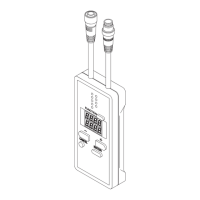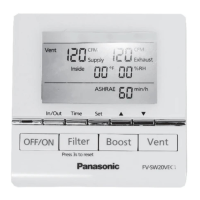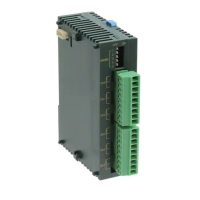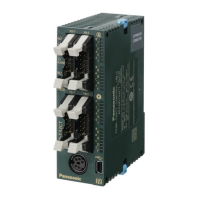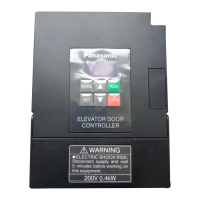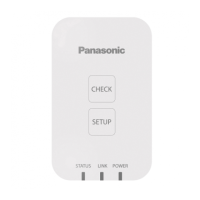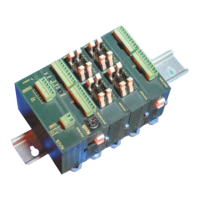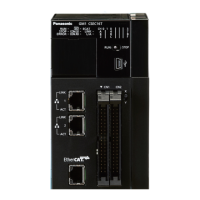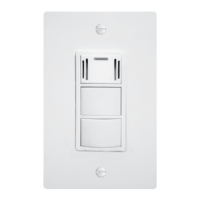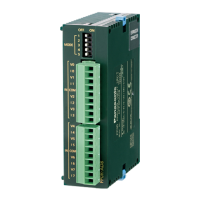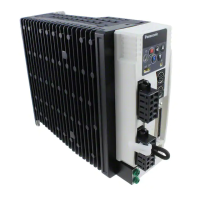58
Chapter 2
Starting
Automatic refresh
If the CPU of the QnA, QnS, or Q series is used, automatic refresh is possible. Use the parameter setting or CC-
Link setting function to set the data. The remote registers, however, cannot be automatically refreshed for the bit
devices (X, Y, etc.). In this case, use the data memory, or execute the FROM / TO command to refresh the bit
devices.
Presetting
Select a presetting pattern to simplify the I/O setting operation.
You can select a pattern from 16 presetting patterns (15 presetting patterns and no presetting).
• If inputs and outputs are already set, select ‘no presetting.’ The set conditions of the inputs and outputs will
not be changed.
• If buffer memory assignment pattern 1 is selected, 128 input points and 128 output points can be preset.
If the buffer memory assignment pattern 2 is used, 256 input points and 256 output points can be preset.
Separately set the number of I/O control points.
● Presetting values
Buffer memory assignment pattern 1
Address
Presetting pattern number
0 1 2 3 4 5 6 7 8 9 A B C D E F
0 to 31
No presetting
IN IN IN IN OUT OUT OUT OUT OUT OUT OUT OUT IN IN IN
32 to 63 IN IN IN OUT OUT OUT OUT OUT OUT OUT OUT IN IN IN IN
64 to 95 IN IN OUT OUT OUT OUT OUT OUT OUT OUT IN IN IN IN IN
96 to 127 IN OUT OUT OUT OUT OUT OUT OUT OUT IN IN IN IN IN IN
128 to 159 OUT OUT OUT OUT IN IN IN IN IN IN IN IN OUT OUT OUT
160 to 191 OUT OUT OUT IN IN IN IN IN IN IN IN OUT OUT OUT OUT
192 to 223 OUT OUT IN IN IN IN IN IN IN IN OUT OUT OUT OUT OUT
224 to 255 OUT IN IN IN IN IN IN IN IN OUT OUT OUT OUT OUT OUT
Buffer memory assignment pattern 2
Address
Presetting pattern number
0 1 2 3 4 5 6 7 8 9 A B C D E F
0 to 31
No presetting
IN IN IN IN IN IN IN IN OUT OUT OUT OUT OUT OUT OUT
32 to 63 IN IN IN IN IN IN IN OUT OUT OUT OUT OUT OUT OUT OUT
64 to 95 IN IN IN IN IN IN OUT OUT OUT OUT OUT OUT OUT OUT IN
96 to 127 IN IN IN IN IN OUT OUT OUT OUT OUT OUT OUT OUT IN IN
128 to 159 IN IN IN IN OUT OUT OUT OUT OUT OUT OUT OUT IN IN IN
160 to 191 IN IN IN OUT OUT OUT OUT OUT OUT OUT OUT IN IN IN IN
192 to 223 IN IN OUT OUT OUT OUT OUT OUT OUT OUT IN IN IN IN IN
224 to 255 IN OUT OUT OUT OUT OUT OUT OUT OUT IN IN IN IN IN IN
256 to 287 OUT OUT OUT OUT OUT OUT OUT OUT IN IN IN IN IN IN IN
288 to 319 OUT OUT OUT OUT OUT OUT OUT IN IN IN IN IN IN IN IN
320 to 351 OUT OUT OUT OUT OUT OUT IN IN IN IN IN IN IN IN OUT
352 to 383 OUT OUT OUT OUT OUT IN IN IN IN IN IN IN IN OUT OUT
384 to 415 OUT OUT OUT OUT IN IN IN IN IN IN IN IN OUT OUT OUT
416 to 447 OUT OUT OUT IN IN IN IN IN IN IN IN OUT OUT OUT OUT
448 to 479 OUT OUT IN IN IN IN IN IN IN IN OUT OUT OUT OUT OUT
480 to 511 OUT IN IN IN IN IN IN IN IN OUT OUT OUT OUT OUT OUT
<Example>
If buffer memory assignment pattern 1 is selected and the presetting pattern number is set to ‘E,’ addresses 0 to
127 will be input addresses, and addresses 128 to 255 will be output addresses.
In this case, if the number of I/O control points is set to ‘192,’ addresses 0 to 127 will be input addresses, and
addresses 128 to 191 will be output addresses.

